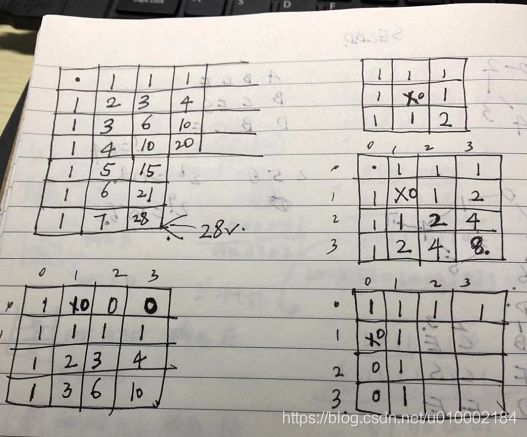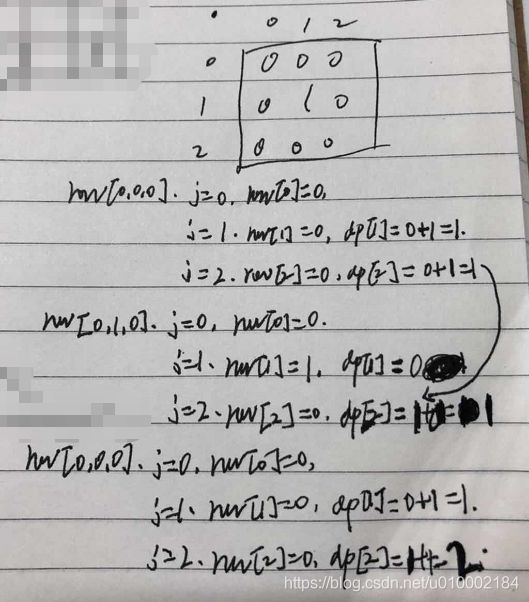LeetCode 63. Unique Paths II--二维数组从左上角到右下角的唯一路径的种数有多少,有1的位置不能走,只能向右或向下移动--2D DP
A robot is located at the top-left corner of a m x n grid (marked 'Start' in the diagram below).
The robot can only move either down or right at any point in time. The robot is trying to reach the bottom-right corner of the grid (marked 'Finish' in the diagram below).
Now consider if some obstacles are added to the grids. How many unique paths would there be?
![]()
An obstacle and empty space is marked as 1 and 0 respectively in the grid.
Note: m and n will be at most 100.
Example 1:
Input:
[
[0,0,0],
[0,1,0],
[0,0,0]
]
Output: 2
Explanation:
There is one obstacle in the middle of the 3x3 grid above.
There are two ways to reach the bottom-right corner:
1. Right -> Right -> Down -> Down
2. Down -> Down -> Right -> Right方法1:仍然在原二维数组存储,没有开辟新的数组
public class Leetcode_63_Unique_Paths_II {
public static void main(String[] args) {
/* int[][] obstacleGrid = new int[][]{
{0, 0, 0, 0},
{0, 1, 0, 0},
{0, 0, 0, 0},
{0, 0, 0, 0}};
*/
int[][] obstacleGrid = new int[][]{
{0, 0, 0,},
{0, 1, 0},
{0, 0, 0,}};
System.out.println(new Leetcode_63_Unique_Paths_II().
uniquePathsWithObstacles(obstacleGrid));
}
public int uniquePathsWithObstacles(int[][] obstacleGrid) {
//如果开头的左上角是1,则无法继续,直接返回0
if (obstacleGrid != null && obstacleGrid[0][0] == 1) {
return 0;
}
//把第一行从0更新为1,如果该元素是1,则该行之后的元素(右边的元素)都不可达,都需要设置为0
for (int i = 0; i < obstacleGrid[0].length; ) {
if (obstacleGrid[0][i] == 0) {
obstacleGrid[0][i] = 1;
i++;
} else if (obstacleGrid[0][i] == 1) {
for (; i < obstacleGrid[0].length; i++) {
obstacleGrid[0][i] = 0;
}
}
}
// for (int i = 0; i < obstacleGrid.length; ) {//[0,0]已经从0变为1,所以此时要从第二行开始往下
//把第一列从0更新为1,如果该元素是1,则该列之后的元素(下边的元素)都不可达,都需要设置为0
for (int i = 1; i < obstacleGrid.length; ) {
if (obstacleGrid[i][0] == 0) {
obstacleGrid[i][0] = 1;
i++;
} else if (obstacleGrid[i][0] == 1) {
for (; i < obstacleGrid.length; i++) {
obstacleGrid[i][0] = 0;
}
}
}
for (int row = 1; row < obstacleGrid.length; row++) {
for (int column = 1; column < obstacleGrid[0].length; column++) {
if (obstacleGrid[row][column] == 1) {
obstacleGrid[row][column] = 0;//如果不可达,则元素需设置为0
} else {
obstacleGrid[row][column] = obstacleGrid[row - 1][column] + obstacleGrid[row][column - 1];
}
}
}
return obstacleGrid[obstacleGrid.length - 1][obstacleGrid[0].length - 1];
}//uniquePathsWithObstacles
}
方法2(不太好懂):用一维数组存储中间值,开辟了新的数组
/**
* @Desc
* @Author liuyazhou
* @CreateTime 2018/11/18 17:46
**/
public class LeetCode_63_UniquePathsII {
public static void main(String[] args) {
int[][] obstacleGrid = new int[][]{{0, 0, 0}, {0, 1, 0}, {0, 0, 0}};
System.out.println(new LeetCode_63_UniquePathsII().uniquePathsWithObstacles(obstacleGrid));//2
obstacleGrid = new int[][]{{0}};
System.out.println(new LeetCode_63_UniquePathsII().uniquePathsWithObstacles(obstacleGrid));//1
obstacleGrid = new int[][]{{1}};
System.out.println(new LeetCode_63_UniquePathsII().uniquePathsWithObstacles(obstacleGrid));//0
}
public int uniquePathsWithObstacles(int[][] obstacleGrid) {
int c = obstacleGrid[0].length;//列数
int[] dp = new int[c];
dp[0] = 1;//别忘了初始化
for (int[] rows : obstacleGrid) {
for (int j = 0; j < c; j++) {
if (rows[j] == 1) {
dp[j] = 0;
} else if (j > 0) {
dp[j] = dp[j] + dp[j - 1];
}
}
}
return dp[c - 1];
}
/* public int uniquePathsWithObstacles2(int[][] obstacleGrid) {
int m = obstacleGrid.length;
int n = obstacleGrid[0].length;
int[] dp = new int[n + 1];
dp[1] = 1;
for (int i = 0; i < m ; i++) {
for (int j = 1; j <=n; j++) {
if(obstacleGrid[i][j-1] == 1){
dp[j] = 0;
}else {
dp[j] += dp[j -1];
}
}
}
return dp[n];
}*/
}
More explanation:
This is a typical 2D DP problem, we can store value in 2D DP array,
but since we only need to use value at dp[i - 1][j] and dp[i][j - 1] to update dp[i][j],
we don't need to store the whole 2D table, but instead store value in an 1D array, and update data by using dp[j] = dp[j] + dp[j - 1],
(where here dp[j] corresponding to the dp[i - 1][j]) and dp[j - 1] corresponding to the dp[i][j - 1] in the 2D array)LeetCode 62. Unique Paths--二维数组从左上角到右下角的唯一路径的种数有多少,只能向右或向下移动--DP

